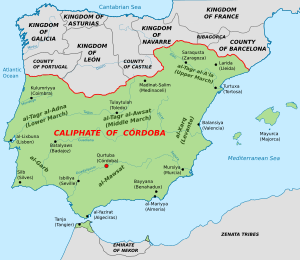Fitna of al-Andalus facts for kids
Quick facts for kids Fitna of al-Andalus |
|||||||
|---|---|---|---|---|---|---|---|
 Caliphate of Córdoba (green), c. 1000. |
|||||||
|
|||||||
| Belligerents | |||||||
| Muslim rebels | |||||||
The Fitna of al-Andalus (1009–1031) was a big civil war in the Caliphate of Córdoba. This was a powerful Muslim kingdom in what is now Spain and Portugal. The war started in the year 1009 with a sudden change in power.
This change involved the killing of Abd al-Rahman Sanchuelo. He was the son of a very powerful leader named Almanzor. The ruler, known as the Caliph Hisham II al-Hakam, was also removed from power. Instead, Muhammad II of Córdoba, who was a great-grandson of an earlier ruler, took over.
The conflict caused the entire region of Al-Andalus to break apart. It split into many smaller kingdoms called Taifas. The Fitna finally ended in 1031 when the Caliphate of Córdoba was officially ended. However, some of the new kingdoms still claimed to be the true caliphs.
During this time, there were also big money problems. People had to pay a lot of taxes to pay for the constant fighting. This made life very hard for many.
Throughout the war, different Muslim kingdoms got help from Christian kingdoms to the north. This help came from official agreements and also from Christian soldiers who worked as mercenaries. The city of Córdoba and its surrounding areas were robbed many times during the war. Many famous buildings, like the Alcázar de los Reyes Cristianos and the Medina Azahara, were destroyed. For a while, the capital city was even moved to Málaga. In less than twenty years, ten different rulers claimed to be theiphs. Three of these rulers were part of a family called the Hammudid Dynasty.
What Caused the War?
Up until the year 976, the Caliphate of Córdoba was a very strong state. Christian kingdoms to the north respected and feared it. But after the ruler Al-Hakam II died, his son, Hisham II al-Hakam, was still a child.
Because of this, a powerful minister named Almanzor easily took control. He took over the power of the Umayyad Caliphate and made the Caliph a puppet ruler. The Caliphate's strength came from different Muslim groups working together. Almanzor wanted to keep his power, so he favored the Berbers over other groups.
When Almanzor died, his son Abd al-Malik al-Muzaffar took his place. He continued to favor the Berbers. This made the situation worse, as other groups tried to gain power. Abd al-Malik died in 1008, and his brother, Abd al-Rahman Sanchuelo, took over. Sanchuelo convinced Caliph Hisham II to name him as the next ruler. This was the final straw for the remaining members of the Umayyad family. They launched a full-scale revolt against the government.
The Civil War Begins
While Sanchuelo was away fighting against the forces of Alfonso V of León, a leader named Muhammad II of Córdoba took advantage. In 1009, he removed his cousin, Caliph Hisham II al-Hakam, from power. Sanchuelo quickly returned to Córdoba. But his Berber army was tired from the long fight, and many soldiers left him. Because of this, Muhammad II captured Sanchuelo and had him killed soon after.
After this, Muhammad II became very powerful. But this led to new problems. Another Umayyad group, led by Sulayman ibn al-Hakam, rose up against him. Sulayman had the support of the Berbers. He managed to capture Muhammad II and became the Caliph in 1009.
This series of events then caused the Hammudid Dynasty to get involved. They were a powerful family from cities like Ceuta and Algeciras. They declared themselves the rightful Caliphs and marched on Córdoba. They removed Sulaiman from power and ruled until 1023.
In 1023, a new Umayyad ruler, Abd ar-Rahman V, became Caliph. Sadly for him, he introduced a new tax that made people very unhappy. This caused another revolt, and he was soon removed from power.
Three more Caliphs ruled after him, two from the Umayyad family and one from the Hammudi family. This continued until 1031. In that year, the leaders in Córdoba decided to end the caliphate completely. They set up an independent state called a taifa. However, different leaders from various taifas still claimed to be the true caliph.
What Happened After the War?
This period of chaos, started by the Hammudid Dynasty, caused the caliphate to break into many pieces. This led to the creation of the first independent Taifa kingdoms. It's important to know that the Christian kingdoms to the north often supported this trouble. They would lend soldiers to both sides, which helped keep things unstable.
The time after the caliphate broke apart was not peaceful. The individual taifas fought among themselves. The Christian kingdoms saw this weakness and a chance to take land. They increased their efforts in the ongoing Reconquista, which was the Christian reconquest of the Iberian Peninsula. It was only when Muslim control in the Iberian Peninsula was truly threatened that the Almoravid dynasty finally came to help. They aimed to bring Al-Andalus back together under one rule.
See also
 In Spanish: Fitna de al-Ándalus para niños
In Spanish: Fitna de al-Ándalus para niños

